News and Analysis regarding scarce coins, markets, and coin collecting #320
A Weekly CoinWeek Column by Greg Reynolds …..
The present topic is collecting Classic Head half eagles (U.S. $5 gold coins) that cost less than $5,000 USD each, with emphasis upon the availability of Extremely Fine to AU grade coins and scarcity estimates. Half eagles of the Classic Head design type were produced from 1834 to 1838, and collectors may finish a set without much difficulty.
U.S. half eagles were first minted in 1795 and were last struck for commerce in 1929. Classic Head quarter eagles were the focus of a previous discussion. (Words in blue may be clicked to access references.)
Modern U.S. $5 gold pieces, with the same physical specifications as early 20th century half eagles, have been issued for commemorative purposes and for collectors since 1986. In concept and meaning, modern $5 gold pieces are different from the half eagles that date from 1795 to 1929.
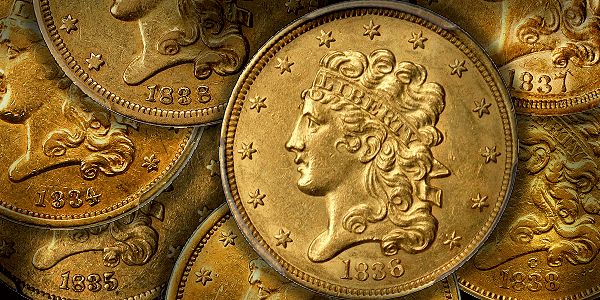
For collectors who like half eagles, yet cannot afford to spend much per coin, a previous discussion was devoted to Indian Head half eagles (1908-29) that cost less than $500 each. For 19th-century half eagles, it is best to budget substantially more than $500 per coin.
Classic Head half eagles are extremely scarce, are historically important and are enjoyable to collect. For less than $5,000 per coin, a set of Classic Head half eagles may be completed. It is probably practical to fill such a set with appealing, relatively original, Fine to AU grade coins.
By tradition, not for scientific reasons, coins are graded on a scale from 01 to 70: Poor-01; Fair-02; AG-03; Good-04, 06; VG-08, 10; Fine-12, 15; Very Fine -20, 25, 30, 35; Extremely Fine (‘XF’)-40, 45; AU-50, 53, 55, 58; ‘Mint State’ -60 to -70. There is a free online grading reference at pcgs.com, which is helpful for grading circulated coins. For early gold coins that grade AU-53 or higher, images are really not particularly useful.
Auction prices are cited herein to provide a general idea of pertinent market levels. Specific coins are not being recommended and collectors should consult experts rather than relying entirely upon certifications. The same grading service may assign a different grade to the same coin at a different time.
There are many variables regarding certified, classic U.S. coins. Aesthetic issues and/or problems that may be responsible for differences in value among two coins of the same date with the same certification. Material on the surfaces of early U.S. gold coins may be natural, relating to normal storage, or may have been deliberately added to deflect attention from imperfections. In cases where naturally cloudy dust, hazes, added wax, natural or added films, added powder or putty are present, such substances can often (though not always) be easily removed with acetone or sometimes just with running water.
For coins of any grade, the degree of originality cannot be effectively evaluated from images. “For the most part, Very Fine to XF, Classic Head fives are more original than AU grade coins,” John Albanese has found. John has been the foremost expert in rare U.S. gold coins for decades. Albanese founded CAC in 2007.
Classic Head half Eagles – The Series
“Classic Head half eagles are fun to collect and the set is obviously completable,” Albanese declares. There are eight ‘dates’: 1834-‘Plain 4,’ 1834-‘Crosslet 4,’ 1835, 1836, 1837, 1838 Philadelphia Mint, 1838-Charlotte Mint, and 1838-Dahlonega Mint. In the field of coin collecting, the term ‘date’ means more than just a year.
A ‘C’ mintmark refers to the Branch U.S. Mint in Charlotte, North Carolina. Such a ‘C’ mintmark should not be confused with a ‘CC’ mintmark, which refers to the branch in Carson City, Nevada. U.S. coins were not struck in Carson City until 1870 and not in Denver until 1906. In the context of 19th century U.S. coins, a ‘D’ mintmark refers to the Branch U.S. Mint in Dahlonega, Georgia, which was closed by Confederate forces in 1861.
From 1793 to 1837, all U.S. coins were struck at the Philadelphia Mint. Before 1942, coins struck at the Philadelphia Mint did not have mintmarks.
For the design type of Classic Head half eagles, there are no readily apparent overdates. The 1834-‘Plain 4’ and the 1834-‘Crosslet 4’ are two different dates; two whole different styles of the numeral ‘4’ were employed on coins of the same year at the same mint. This distinction is clear to someone without a magnifying glass. Therefore, someone collecting ‘by date’ needs two 1834 Classic Head half eagles for a complete set.
‘By date,’ Classic Head half eagles are very scarce to very rare. A formal definition of the term rare applies to coins for which fewer than five hundred survive. A coin is very rare if less than 250 exist in the present.
If fewer than 2500 survive, including those in all states of preservation, a coin is very scarce. Perhaps 1,000 or 1250 is a logical dividing line for separating extremely scarce coins from very scarce coins. More than a few less scarce coins in many other series of U.S. coins are far more expensive than Classic Head half eagles.
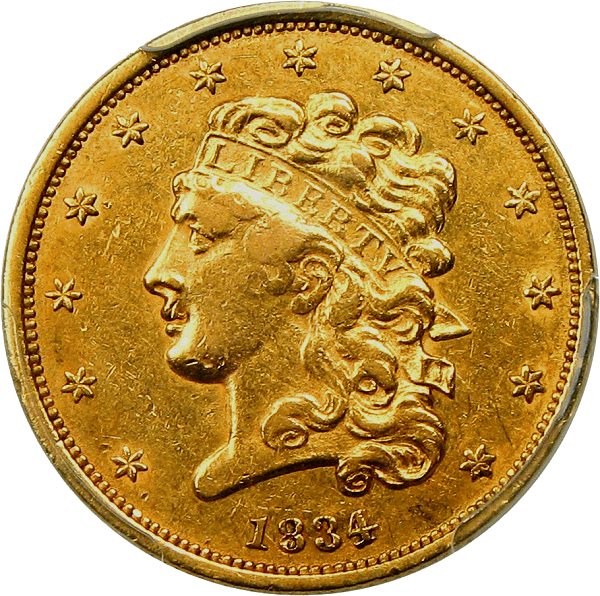 1834 – ‘Plain 4’
1834 – ‘Plain 4’
It is easy to acquire an 1834-‘Plain 4.’ Although PCGS and NGC together have ‘graded’ around 3500 1834-‘Plain 4’ half eagles, this total probably represents just 2,000 coins, at most. Grade-inflation has been a factor. Certainly, there are another three hundred to six hundred that are clearly non-gradable or have not yet received numerical grades at PCGS or NGC. Probably, fewer than 2500 exist. If so, the 1834-‘Plain 4’ is a very scarce date, though hardly a rarity.
This month alone, Heritage has sold three 1834-‘Plain 4’ half eagles. The best value of these three might possibly be an NGC graded EF-45 coin, with CAC approval, as it brought less than $1,000. An NGC-authenticated, damaged coin, with the details of an Extremely Fine grade, went for just $458.25, maybe another good value. An NGC-graded MS-62 coin garnered $4230.
In November 2013, Stack’s Bowers auctioned a PCGS-graded EF-40 1834-‘Plain 4’ for $677.98. In June 2014, this same firm sold a PCGS-graded AU-50 coin for $998.75. There are many coins of this date around from which to choose.
1834- ‘Crosslet 4’
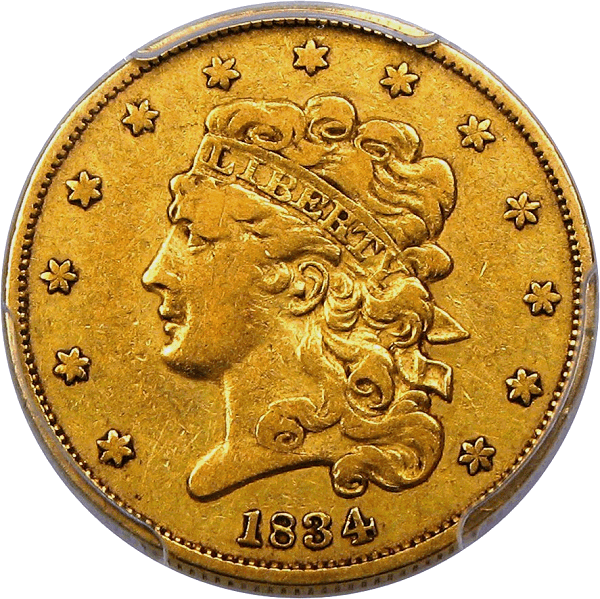 The 1834-‘Crosslet 4’ is very rare. It is almost certain that fewer than 250 are known in all states of preservation. I estimate around 185.
The 1834-‘Crosslet 4’ is very rare. It is almost certain that fewer than 250 are known in all states of preservation. I estimate around 185.
CAC has approved just 10, none of which grade higher than AU-55! The combined PCGS and NGC total of 192 includes many multiple counts of the same coins. Even so, there are also quite a few non-gradable pieces around, including raw pieces that may be misrepresented by salespeople as being of higher quality than experts would determine them to be.
At the FUN Convention auction in January, an NGC-graded AU-53 1834-‘Crosslet 4’ brought just under $5,000. It is not clear that this coin would have received a numerical grade if it had been submitted 20 years ago to NGC or PCGS. In December, a coin that was found by experts at NGC to have been ‘improperly cleaned’ with the details of an Extremely Fine grade coin, brought just $1,527.50, perhaps a sound purchase given the rarity of this issue.
In September 2012, the Goldbergs auctioned a PCGS graded VF-30 coin for $3,106. Last April, Heritage sold a PCGS graded VG-08 coin for $1057.50. Would it qualify for a CAC sticker, if submitted? Given the rarity of the coin, though, a decent piece, if that is a decent piece, for around $1,000 would be an excellent value. Over the last six years, there have been several non-gradable 1834-‘Crosslet 4’ half eagles that have sold at auction for amounts in the range from $2,000 to $4,000.
1835
Although the estimate on PCGS CoinFacts is “850” survivors, it is hard to believe that there are even that many 1835 half eagles. My tentative estimate is 620.
Although PCGS reports 39 as grading AU-58, a fair hypothesis is that this total refers to 21-26 different coins. During the last five years, PCGS-graded AU-58 1835 half eagles have been selling at auction for amounts between $2,000 and $3,000.
PCGS graded AU-55 1835 half eagles have been realizing amounts from around $1,300 to $2,415, except one that Stack’s Bowers auctioned for $4,112.50 in March 2013. My guess is that leading bidders figured this coin to be a candidate for an upgrade. Indeed, images suggest the possibility that it had been under-graded by PCGS.
Last November, Stack’s Bowers auctioned a PCGS-graded EF-45 1835 for $793.13. Logically, this is a reasonable price for an 1835 gold coin that is extremely scarce, nearly rare. Collectors frequently pay much higher amounts for common coins from the early 20th century.
1836
 After the 1834 ‘Plain 4,’ the 1836 is the least scarce date of the design type, though it is very scarce. There are, at most, 1500 coins in existence. For this issue, PCGS and NGC data include an unusually large number of instances of multiple counts of the same coins.
After the 1834 ‘Plain 4,’ the 1836 is the least scarce date of the design type, though it is very scarce. There are, at most, 1500 coins in existence. For this issue, PCGS and NGC data include an unusually large number of instances of multiple counts of the same coins.
In June 2012, Stack’s Bowers sold a PCGS-graded AU-55 1836 for $2,261.88. PCGS-graded AU-50 1836 half eagles have recently tended to sell at auction for prices ranging from $1,000 to $1,200. Prices realized for NGC-graded 1836 half eagles varied widely over the last six years. By January 2010, coin markets had recovered from the recession of late 2008 and much of 2009.
A substantial number of PCGS- or NGC-graded EF-45 1836 half eagles have traded over the last six years, and these tend to sell at auction for less than $1,000 each. A collector may consider spending as much as $1,150 to buy a relatively problem-free EF-45 grade 1836 from a trusted dealer.
1837
The PCGS CoinFacts survival estimate of “350” must be too low. There would have to be more than 400 1837 half eagles in existence, perhaps 440? In any event, this date seems to be rare. Here is an example of an unrecognized rarity that can certainly be acquired for a price well under $5,000!
Over the last few years, PCGS- or NGC-graded AU-58 1837 half eagles tend to sell at auction for amounts between $3,450 and $4,700. In the current market environment, PCGS- or NGC-graded AU-55 coins would probably sell at auction for less than $2,000 each, if consigned. About a year ago, Stack’s Bowers auctioned a PCGS-graded AU-53 1837 for $1,527.50.
1838 Philadelphia Mint
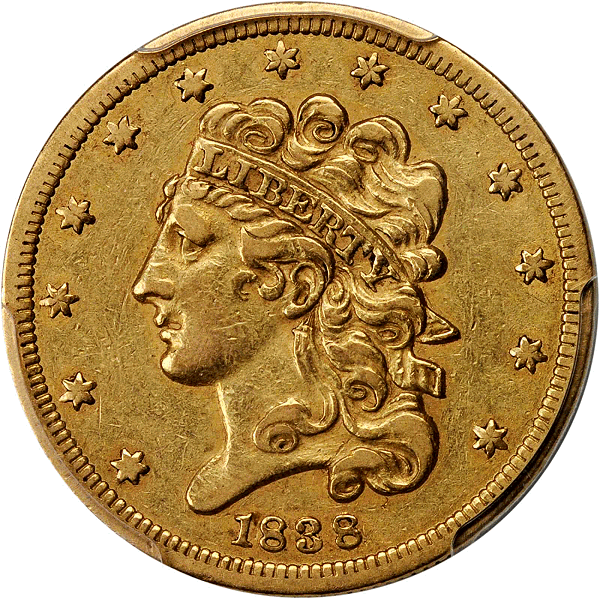 The 1838 is not a rare date, though it is extremely scarce. There may be only around 825 1838 half eagles in existence.
The 1838 is not a rare date, though it is extremely scarce. There may be only around 825 1838 half eagles in existence.
The NGC census of “134” grading AU-58 almost certainly refers to much fewer coins in actuality. Over the past twenty years, it has become routine for certified “AU-58” grade gold and silver coins from the 1830s to be ‘cracked out’ and resubmitted over and over again with the idea of receiving a “Mint State” grade. PCGS reports 31 as grading “AU-58” and CAC has approved 17 at this level.
Collectors now are able to acquire a PCGS- or NGC-graded AU-58 1838 for less than $3,000. It is true that, in July 2013, Legend auctioned a PCGS-graded AU-58 1838, which was earlier in the Norweb Family Collection, for $5,318.75. This result may be an anomaly or leading bidders may have figured that the Norweb 1838 was under-graded by PCGS.
In October 2015, Heritage auctioned a PCGS-graded AU-58 1838 for $2,585. On December 14, 2014, the firm of GreatCollections sold a PCGS-graded AU-55 1838 for $1,854.60.
In August 2014, Stack’s Bowers auctioned the Ferrendelli 1838, which was PCGS graded as AU-55, for $1880. It was one of the better coins in the Ferrendelli Collection, definitely gradable and just moderately dipped in the past. The AU-55 grade assignment was acceptable to most, though I doubt that it would qualify for a CAC sticker.
In November 2015, Stack’s Bowers auctioned a PCGS-graded EF-45 1838 for $940. Buying an EF-45 grade 1838 half eagle for less than $1,000 may be an attractive notion to many coin collectors.
1838 Charlotte Mint
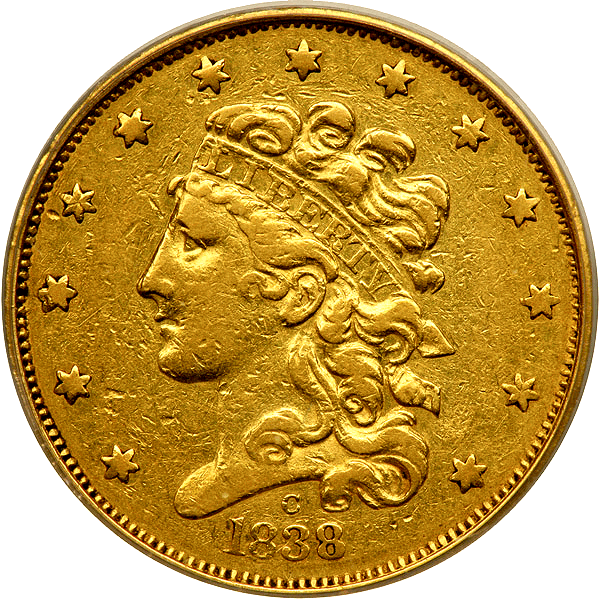 The 1838-C is very rare and is subject to more collector demand than Philadelphia Mint Classic Head half eagles. These are thus expensive.
The 1838-C is very rare and is subject to more collector demand than Philadelphia Mint Classic Head half eagles. These are thus expensive.
There are many collectors who focus upon coins that were struck in Charlotte, North Carolina, and Dahlonega, Georgia. These relate to the Southern Gold Rush, which has been overshadowed by the California Gold Rush. The 1838-C is the only Classic Head half eagle that was minted in Charlotte.
A PCGS- or NGC-certified VF-20 to VF-30 grade 1838-C could be acquired for less than $5,000. In January 2016, Heritage auctioned a PCGS-graded Fine-15 coin for $3,290. The reverse of that 1838-C has some issues, though graders tend to be lenient when interpreting Fine grade early gold coins.
In February 2014, in Atlanta, the Bently Collection, NGC-graded VF-25 1838-C brought $4,406.25. In November 2012, Stack’s Bowers auctioned a PCGS-graded VF-20 1838-C, which realized $3,795. Some collectors may find that more than a few of the 1838-C half eagles in ‘Genuine’ or ‘Details’ holders are better values than these two ‘Very Fine’ coins.
In the past, I have quoted Warren Mills to the effect that many coins that were regarded by experts at PCGS and NGC to be non-gradable during the 1990s are now considered to be gradable. For pre-1840 gold coins, it is especially difficult to define a boundary between the gradable and ungradable. Several wholesalers keep ‘cracking out’ particular coins in ‘Genuine’ or ‘Details’ holders with the idea that a numerical grade will eventually be assigned to them.
There are dozens of 1838-C half eagles that, so far, have been judged to be non-gradable, which cost from $1000 to $2500 each. Also, some non-gradable coins have problems that are dramatically more severe than the problems of others. It does not make sense to assume that all of the problems will be noted on the label (‘insert’) within each holder. It is a good idea to consult experts about the precise physical characteristics of specific coins.
1838 Dahlonega Mint
Although the 1838-D is not as rare as the 1838-C, the 1838-D is rare, perhaps 310 are known including those in all states of preservation. It is harder to find a PCGS or NGC, numerically graded 1838-D for a price below $5,000 than an 1838-C. VG-10 to VF-20 grade 1838-D half eagles appear from time to time. A few non-gradable 1838-D half eagles are very much original but have deep scratches or gashes.
“For the Charlotte and Dahlonega coins, a collector should have patience,” Albanese asserts. Warren Mills“Many have been scrubbed. It may take years to find nice, original coins.”
Among design types that lasted for more than two years, Capped Head half eagles (1813-34) are the most difficult series to even 80% complete ‘by date.’ As a consequence, some collectors are frightened by early half eagles, without realizing that Bust Left half eagles and Classic Head half eagles tend to be much more obtainable than Capped Head half eagles.
Indeed, It is puzzling that more collectors are not aware that is currently not difficult to assemble a truly complete set of Classic Head half eagles. For less than $5000 per coin, often much less, collectors may have the satisfaction of really finishing a set of an entire design type of half eagles, including true rarities!
©2016 Greg Reynolds




